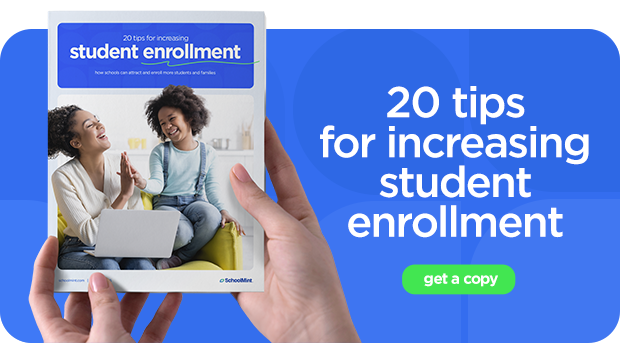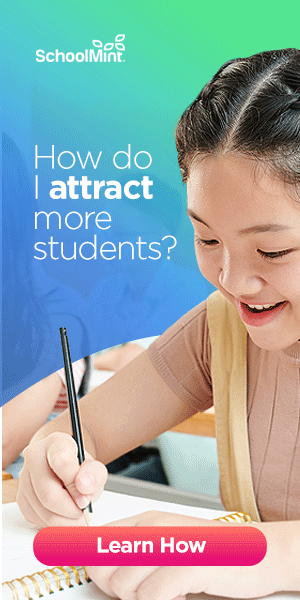Using Customer Personas to Increase Enrollment
Here’s how creating “customer personas” of parents in your community can help your school increase enrollment.
If you think about the best brands or products — from Coca-Cola to Amazon to Apple — they all have one thing in common: they know their customers inside and out.
Apple, for example, understands that their most loyal customers want more than phones and computers. Apple’s customers want stylish tools that help them express themselves and stay connected, and they’re willing to pay a premium price to get them.
Of course, market-leading companies like Apple can spend millions of dollars every year digging into the minds of customers to understand their needs and motivations.
However, every organization, even one with a limited marketing budget — like your school — should be doing the same kind of analysis to understand what makes their customers tick.
In fact, the more limited your marketing budget, the more important it is to understand exactly who you are trying to reach with your marketing efforts. To market effectively, you have to clearly know which families you’re attempting to serve.
The best way to understand the motivations of the families who chose your school, as well as the families you would like to attract to your school, is to create what’s called a customer persona.
In fact, creating customer personas is the foundational first step to creating an effective school marketing plan.
Table of Contents
1. What is a Customer Persona?2. Customer Persona Case Study: An “Alternative” Charter
3. Building Customer Personas for Your School
4. Demographics Are Not Destiny
5. The Elements of a Customer Persona
6. Takeaway
What is a Customer Persona?
Think of a customer persona like a fictional character you create to represent your current or target customer — for you, your target “customer” is the type of parent your school serves, that you want to serve, or both.
Like any character, your customer persona has specific demographic traits (such as age, sex, income, race, etc.), but they are much more than that. Your customer persona must explore this individual’s beliefs and motivations.
To make this fictional character even more real in your mind, give them a name, maybe even a face. When the customer persona is complete, you should understand this person inside and out so you can use this information to help you attract them to your school.
This isn’t to say that the real-life families at your school aren’t varied and complex. They are! However, no matter how unique each family is, I guarantee that, as a group, they share certain traits.
By creating customer personas, you’ll be able to identify those commonalities and more effectively communicate with these families, helping persuade them to choose your school.
This approach applies to public and charter schools just as much as it does to private, independent, and religious schools.
Even if your school accepts all comers, you still want to make sure you are attracting the kinds of families who will succeed at your school and who will help your school succeed at the same time.

Customer Personas in Action
Before we begin the process of creating customer personas for your school, it’s important to understand when exactly you will want to reference these personas to help you make decisions about marketing and communication. The answer: all the time.
Your customer personas should influence every decision you make about your school’s marketing and communication strategies.
For example, say you’re trying to determine the most effective way to use your school’s limited marketing budget. Should you invest in print advertisements? Online advertisements? Direct mail? Email marketing?
The answer, of course, lies in your customer personas. Which parents and students are you trying to reach? For example:
- Are you a neighborhood district school wanting the enrollment of the families who live within a five-mile radius of your school?
- Are you a new STEM-centric charter trying to find young, busy, tech-savvy parents?
- Are you an established Catholic school trying to reach church-going families in a neighboring parish?
Either way, you need to clearly understand who your customers are before you can decide how to target them.
Note that sometimes the families you may be trying to reach may not necessarily be like the families who are already enrolled with you.
Customer personas are useful for understanding both the families who are already part of your school as well as identifying the families who you would like to attract to your school.
Identifying and understanding these “target” families is essential for your school to reach its potential.
Customer Persona Case Study: An “Alternative” Charter
One success I had using customer personas was helping a charter school that defined itself as an “alternative” high school. Their enrollment was strong, but they weren’t attracting the kinds of students they knew they needed to make their school succeed.
Instead of attracting freshmen and sophomores who would grow with the school and help create a tight-knit community, they were disproportionately attracting juniors and seniors, many of whom struggled with significant behavioral challenges.
Our first step was to spend time talking to the parents and the students who currently attended the school to understand what persona to target.

The first key insight we gained was that the use of the term “alternative school” was very polarizing.
Though this term is understood in the education world, what this client didn’t appreciate was that, to parents and students in their community, this phrase conjured up images of students who had consistently been in trouble with law enforcement.
When students were asked if they considered themselves students who were in trouble with the law, they all answered “no.”
By removing the phrase “alternative” from the public descriptions of the school and instead describing it as a school for students who “had been unable to find success at their previous school,” they could now attract parents and students who originally didn’t believe the school was a good fit for them.
To help this school find more of the kinds of students they wanted, we created six different customer personas of different kinds of students who would benefit from their school.
Using these personas, we revamped their marketing and communication strategy, shedding their “alternative” image that was scaring families off, and creating a more inclusive, welcoming image of a school that is uniquely set up to help any student who isn’t reaching their potential in their traditional school.
Suddenly, the conversation shifted away from the senior who had been a discipline challenge and a drop-out risk to the freshman who was being bullied — their ideal student type.
This school is now at record enrollment (and opened an additional campus). More importantly, many students who could benefit from this different type of school environment are being served rather than dropping out.

Building Customer Personas for Your School
Now it’s time to create the customer personas for your school.
The first step is to gain a deep understanding of what families you are already serving and what families you are trying to reach. To do that, you need solid market research. Without accurate and actionable data, you will never know who your customers (parents) are and what they really want.
Another essential tool to understanding your customers is to conduct a customer survey. This is the best way to get a reliable, data-driven picture of who you are serving.
Remember, the most important part of a customer persona is developing a real understanding of what motivates your target families.
When the day comes for that family to finally decide where to enroll their child, how will they make that decision? What will be their biggest deciding factor? If you want to know, you have to ask.
Of course, you shouldn’t discount the information you already know about the families you serve.
For example, let’s say you operate a K-6 school located in an urban area. You primarily serve a demographic that is in a lower socioeconomic level.
Just based on this information, you can begin to build a basic customer persona, perhaps like this:
What does this mean? A lot. Based on just this limited demographic information, you can tailor your messages to families. For example:
- People in a low-income bracket tend to primarily use their phone to access the internet. If your website is not mobile-enabled, you are potentially giving a poor customer experience for customers accessing your site via their phone.
- Your potential customers could be at a lower educational attainment level. You need to tailor your communication to resonate with them. Run your material through a Flesch-Kincaid analysis to know if your material is understood by your audience.
- Facebook is the number one social media platform for all people within your demographics, per Pew Research. If you are spreading yourself thin by trying to hit every social media platform, concentrate on Facebook — and knock it out of the park.
- In 2022, approximately 82% of traffic on the internet was video. You need more videos on your website.
Quick note: Your personas may be either students or parents. I usually advise clients to profile students for high school and parents for K-8, but you should do whatever makes the most sense for your school.
Demographics Are Not Destiny
One pitfall to avoid is relying too heavily on cold demographic data. While age, sex, zip code, income, and race can tell us a lot about a person, they can also lead us to make elementary mistakes.
For example, if I were to tell you about a wealthy British man born in 1948, married twice (amid very public scandal), who some consider royalty, you might picture King Charles III.

However, in addition to the former–Prince of Wales, now-King Charles, that demographic data also describes Ozzy Osbourne — known colloquially as the Prince of Darkness.

In the real world, they couldn’t be more different — but on paper, the two can look almost indistinguishable. Unless, of course, we ask the right questions.
That’s why I always tell clients that demographic segmentation is a great first step, but if you want to dive deeply into your customers’ minds, the best way to do that is through individual interviews or focus groups. This will help you truly understand their motivations and desires.
This “attitudinal” segmentation is much richer and allows your message to resonate with your target market. These attitudes might be:
- A prioritization of character building over pure academic results
- A desire to find a school that is more responsive to parents needs vs. test scores
- Desire to find a community of like-minded parents
Remember, you don’t just need to understand who your customers are — you need to understand what your customers want.
Having messaging that resonates with customers on an emotional level is the most effective form of marketing you can create, but it can be difficult to pull these out of customers. This might be when you bring in some professional help.
The Elements of a Customer Persona (with a Bonus Worksheet)
Once you have your research in hand, it’s time to dig in and define who your customers are.
Here’s a worksheet I like to share with clients that separates out the different questions we’re going to answer.
Remember, you will likely want to create multiple customer personas, so don’t feel as if you need to shoehorn every possible customer onto one sheet.
Let’s go through the boxes step by step.
To help you understand what each box is for, I’ll use examples from one of the personas we created for the no-longer-“alternative” school I talked about earlier.
1. Persona Title
The persona title is where you give your customer a name and a one-word description.
For the charter school in our example above, we created a persona named “Disengaged Dave.” I like the alliteration because it’s descriptive and helps you remember who you’re talking about.

2. Description
The description is a broad sketch of the student or parent this persona is based on. Don’t get bogged down in statistics here. Remember, you want this persona to feel as real as possible. This description should help you visualize who this student or parent is. Paint a picture with words.
For my charter school client, we understood Dave as being a student who skips school frequently and doesn’t participate when he’s there. What Dave needs is a school that will re-engage him so he can get his high school diploma and get him on track for a successful life.
3. Demographics
Demographics is where you put the cold, hard numbers and other data you’ve gleaned from your research. Age, income, religious affiliation, etc.
For Dave, we know that he’s 15–19, behind on his credits, and is currently on a path to not graduate high school.
4. Goals/Needs
This is where we really dig into what makes this student or parent tick. This is also where we identify the problems the student or parent has so we can tailor our communication to show how the school can solve those problems.
Dave, for example, needs to graduate high school if he’s going to have a rewarding career. To make this happen, he needs an education environment that is tailored to him as an individual and is more interesting and engaging than his current school.
Fortunately, my charter clients designed their school to help students exactly like Dave. Now the task is convincing him to enroll.
Not every need is going to be the same. Education is obviously the end goal — but are you a school that sends students to Harvard? Do you emphasize social and emotional learning? Are you about creating rich experiences that transcend the classroom?
Just thinking about those three different paths shows you how “quality education” can be described in a dramatically different fashion against a parent or student’s needs.
5. Barriers to Choosing Your School
Of course, getting a student to enroll isn’t as easy as telling them about your program. Part of the process of creating customer personas is understanding what is keeping students from enrolling. Once you understand these barriers, you can work on overcoming them.
For Dave, the biggest problem is that he’s never liked school. He doesn’t see why a new school will be any better. Since academic success isn’t important to him, he sees no reason to change schools. In fact, he might not even know that a different kind of school exists.
On a practical level, Dave doesn’t own a car, so he would never imagine going to a school outside of his immediate neighborhood since he isn’t aware that some charter schools provide transportation.
6. How to Reach Them
Here’s where we turn what we know about this customer into action. Based on what we know about this customer, what are the most effective tools for getting their attention?
When it comes to Dave, he’s pretty obviously not going to show up to an open house or thumb through brochures at a school fair.
If we want Dave to enroll, we’re going to have to meet him where he is. The best way to do this is likely reaching out to his current school and letting them know that you’re looking for a student like Dave.
Additionally, Dave’s a teenager, so if you want to reach him directly, you should focus on digital/mobile ads. Since he has rejected most authority figures at school, perhaps a peer-driven or student-outreach effort would be best.
7. Influencers
Families don’t make big decisions like choosing a school in a vacuum. Typically, they solicit opinions from trusted sources around them in addition to doing their own research.
For Dave, the likely influencers are probably the administration at his current school and his parents, although an even better influencer might be a student who used to be like Dave but whose academic career has turned around at this new school.

8. Goals
Earlier we discussed the goals for your target student, but here we’re going to look at your goals for getting that student to enroll. Notice that these goals aren’t independent of each other.
They’re a progression, creating a path that starts with reaching the student or parent and ends with them walking through your doors as an enrolled student:
- For Dave, your first goal is to make sure he knows your school exists. Nothing will happen without that.
- Once he knows you’re there, you need to let him know that your school is different. Your school is designed for students like him, and your school can help him achieve his goal of graduating.
- Finally, your goal is to convince him to embrace your school’s approach to education and have him enroll.
When you’re finished with the process, you’ll end up with a sheet that looks something like this:
Congratulations!
You’ve taken a huge step toward knowing who your students are and how to reach them.
Takeaway
Customer persona development is one of the most important (and foundational) elements in creating good marketing.
It doesn't matter if you are Apple, Porsche, Pope John Paul II Catholic School, or Large City Public School District — you need to understand your customer, your families, before you can actively market to them.
Share this
You May Also Like
These Related Stories

The Grocery Store Grapevine: How Casual Conversations Affect Student Enrollment

How to Build a Successful Enrollment Email Nurturing Program



